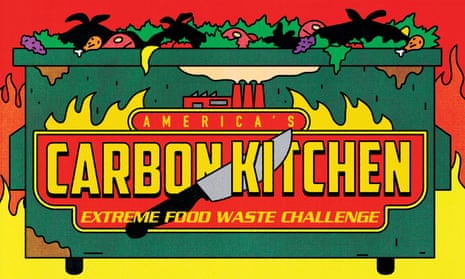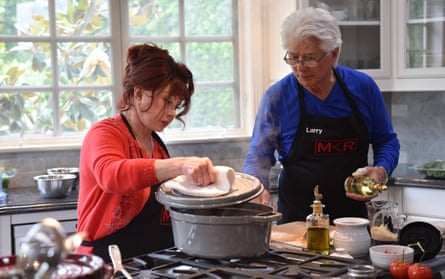A whole dessert unceremoniously dropped into the trash on the Great British Baking Show. Piles of raw chicken used to create a dramatic decorative tableau on Iron Chef. Gas stoves and food frequently catching fire on Chopped. If what we see on TV shapes our aspirations or our sense of what’s normative, cooking shows are ripe for a sustainability makeover.
At a time when climate experts are recommending eating less meat and fewer animal products, switching from gas stoves to electric ones and minimizing food waste, reality TV cooking shows seem to be awash in thick beef steaks, roaring gas flames and tables of food that competition judges barely nibble at. These practices prevailing against a backdrop of rising temperatures and the proliferation of climate disaster seems particularly discordant once you consider that food is responsible for somewhere between a quarter and a third of global greenhouse gas emissions.
Add to that the fact that roughly a third of adults in the US between 18-64 watch reality TV, and the relative lack of climate-responsible behaviors on display in cooking shows begins to look like a missed opportunity indeed.
“The news media has gotten better about how they frame climate change, but entertainment is still behind,” said Cyle Zezo, a former CW executive who previously worked on unscripted shows such as Whose Line Is It Anyway?. “TV has a really tremendous and unique power – and with that should come responsibility. By not reflecting the reality of the world that we’re living in, it’s almost [engaging in] a form of denial.”
So just how big of an effect does a cooking show have on the environment? There are two ways of looking at the answer. The first requires examining the impact the production itself has, and the second requires understanding the cultural or societal influence of the show.
On-set issues
Though viewers may never see exactly what happens to the piles of raw chicken or fish laid on the tables for dramatic effect on Iron Chef, “there’s always going to be food waste on TV”, said the chef Priyanka Naik, who has been the winner of a Food Network competition show and is a frequent guest on the Today Show and the Kelly Clarkson Show.
There are a number of reasons for this. Some shows over-buy ingredients on purpose: there might be 15 bunches of basil purchased to make a recipe that only requires one, just so that there’s plenty of back-up in case something goes wrong, Naik said. Other times, as in the case of Iron Chef, excess ingredients are used as a prop to make a set kitchen look well-stocked or to create striking visuals for TV, even though there’s no plan to actually use it all. In others, waste is built into the premise of the show itself, as when Naik was in a show (which never ended up airing) that involved shooting food out of cannons directly at the chefs.
Plus, judges on cooking competition shows often only eat a few bites of each dish, since they may be required to taste upwards of 12 dishes a day. And programs such as Five Star Chef or the Great British Baking Show include challenges that require contestants to make large quantities of food to prove their skill prepping dishes at scale. While leftover food from cooking shows can often be given to the rest of the crew to eat, hygiene protocols don’t always allow that when a judge or cook has already eaten some, or when dishes have been sitting out too long during filming. Covid has heightened those precautions, said Naik.

Some shows do donate their excess ingredients. The Food Network show Guy’s Grocery Games purports to donate close-to-expiration food from its life-sized set grocery store to food banks once a week, while food scraps “go to a local farm for animal feed”. But according to Zezo, producers face all kinds of time limitations and pressures that keep many from building these kinds of practices into their workflows.
Food waste is just one consideration. Jennifer Sandoval of Earth Angel, an agency that helps Hollywood sets including America’s Test Kitchen: The Next Generation with sustainability, said the most impactful part of almost any set is the kind of energy it relies on, though viewers may never see it. Many productions use external generators powered by fossil fuels, which help make up the largest part of a production’s emissions. After that come the flights taken by cast and crews to get to wherever they’re filming.
Though Sandoval is deeply committed to making sets greener, “probably an even more important thing to focus on is what are you seeing on the screen. That has a lot more potential for really influencing mainstream behavior,” she said. “Having chefs on the show that are very sustainably minded can make a humongous difference.”
Sustainability messaging
Gas stoves are a part of the backdrop of shows from Top Chef to Beat Bobby Flay. But for the sake of the climate and human health, that notion of gas stoves as the norm needs to change, said Sarah Lazarovic, head of communications at non-profit Rewiring America. Lazarovic and her colleagues have been working on shifting the public consciousness around home and building electrification, encouraging people to swap out gas stoves, which leak toxic chemicals that increase risk of asthma and more, for electric stoves, which are better for human and planetary health alike.
Though Lazarovic noted that running gas stoves on set is bad enough, she argued that continuing to normalize or even glamorize gas appliances for the general public probably has a larger negative effect in the long run.
“People take indirect cues; they internalize what they see on screen,” she said.
There’s not much data establishing clear links between what someone watches on TV and what they choose to do in their home kitchen, but at least one study has suggested that what we watch can shape our food waste habits, while other evidence seems to support the idea that TV has influenced everything from drunk driving rates to marriage equality. Researchers at the Rare Entertainment Lab, which is focused on bringing behavioral insights to Hollywood for the sake of the environment, are convinced that we’re going to find even more evidence of TV’s influence on other kinds of behaviors over time.
“When you look at people who watch cooking shows, over half of them have bought something based on what they see on the show,” said Natalia Paine, a food expert at Rare. “So what is happening on screen is already impacting what goes on at home.”
The gas lobby seems to be taking the power of those indirect cues seriously, and has invested heavily in paying TV chefs and social media influencers to combat the growing negative press around gas by having them shill the “benefits” of cooking with gas on shows like My Kitchen Rules, especially as the evidence has continued to mount that gas appliances leak health- and climate-harming chemicals even when they’re turned off.

Paine, of the Rare Entertainment Lab, agrees that the messaging onscreen might be even more important than what happens behind the scenes, though they should ideally happen hand-in-hand; while composting on set is better than throwing food away, composting and showing audiences that you’re doing so is even better.
For the Entertainment Lab’s senior director Ellis Watamanuk, the most effective climate behavior that cooking shows can and should encourage is cooking with less beef, which has a remarkably high climate footprint but which is frequently the star ingredient on shows such as Iron Chef and Chopped. That doesn’t even have to mean eliminating beef entirely, Paine said, “just using it less frequently – maybe once a month versus every day of the week”.
A shift under way
Thankfully, there is reason to believe that, at least in corners of the industry, shifts are under way. When Naik first started auditioning for cooking shows in 2013, she was turned down for being vegetarian (she’s now vegan). “I was constantly rejected from networks because of that, like they didn’t think I was a ‘real’ chef or the network wasn’t ready for a vegetarian chef,” she said. But these days, Naik is a TV regular – and she’s often called upon precisely because of her sustainability expertise, which allows her to offer tips for meals that are meatless or made from leftovers and food scraps.
Zezo, who has been working in TV for over a decade, has seen a shift too. “The feeling in the industry has evolved over the past couple of years in a really big way,” he said. “It’s not anywhere where it needs to be, but it’s more open now.” Zezo himself has been working on Recipe for Disaster, a CW cooking show that debuted this summer and features a plant-based cooking challenge and at least one wisecrack about the climate crisis.
A USC study to be released this fall found 3,500 mentions of climate-related keywords, especially “vegan” and “vegetarian”, in unscripted (AKA “reality”) TV shows from August 2022 to February 2023, a spokesperson said over email. And a smattering of cooking shows, including Netflix’s Best Leftovers Ever!, FYI’s food waste series Scraps: Parts Unseen, HBO Max’s docuseries Zero Waste Chef and the Food Network’s 2012 special, The Big Waste, offer hints at what sustainability-minded cooking programs can look like.
Perhaps most significantly of all, there’s a growing conversation about the responsibility that TV and film have to use their enormous cultural muscle for the good of the planet, with a host of events, resources, non-profits and awards springing up aimed at helping the industry understand the unique role they can have in helping shift culture toward more responsible climate practices.
“It’s incredibly important that we take advantage of this powerful industry that has the ability to drive behavior adoption to address food systems,” said Watamanuk. “I don’t think there is a positive climate future without addressing the diets of Americans and broadly, the global population.”
"food recipes" - Google News
October 24, 2023 at 11:51PM
https://ift.tt/4MPwQio
Recipe for disaster: how good cooking shows can be terrible for the planet - The Guardian
"food recipes" - Google News
https://ift.tt/ZrkfxWs
https://ift.tt/rl5vEWF

No comments:
Post a Comment